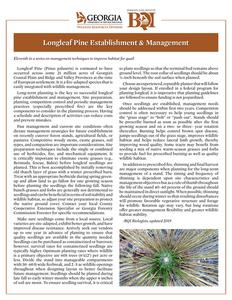BOBWHITE QUAIL INITIATIVE
Longleaf Pine Establishment & Management
Eleventh in a series on management techniques to improve habitat for quail
Longleaf Pine (Pinus palustris) is estimated to have occurred across some 21 million acres of Georgia's Coastal Plain and Ridge and Valley Provinces at the time of European settlement. It is a fire-adapted species that is easily integrated with wildlife management.
Long-term planning is the key to successful longleaf pine establishment and management. Site preparation, planting, competition control and periodic management practices (especially prescribed fire) are the key components to consider in the planning process. Having a schedule and description of activities can reduce costs and prevent mistakes.
Past management and current site conditions often dictate management strategies for future establishment on recently cutover forest stands, agricultural fields, or pastures. Competitive woody stems, exotic grasses, soil types, and compaction are important considerations. Site preparation techniques include the single or combined use of herbicides, fire, and mechanical equipment. It is critically important to eliminate exotic grasses (e.g., Bermuda, fescue, Bahia) before longleaf seedlings are planted. This is best accomplished by initially removing old thatch layer of grass with a winter prescribed burn. Treat with an appropriate herbicide during spring greenup and allow land to go fallow for one growing season before planting the seedlings the following fall. Native bunch-grasses and forbs are generally not detrimental to seedlings and can be beneficial in terms of soil stability and wildlife habitat, so adjust your site preparation to protect the native ground cover. Contact your local County Cooperative Extension Specialist or Georgia Forestry Commission Forester for specific recommendations.
Make sure seedlings come from a local source. Local varieties are site-adapted, exhibit better growth, and have improved disease resistance. Actively seek out vendors up to one year in advance of planting to ensure that quality seedlings are available in the quantity needed. Seedlings can be purchased as containerized or bareroot; however, survival rates for containerized seedlings are typically higher. Optimum planting rates where wildlife is a primary objective are 605 trees (6'x12') per acre or less. Divide the stand into manageable compartments with 3060 ft wide firebreak, and 25 ac wildlife openings throughout when designing layout to better facilitate future management. Seedlings should be planted during late fall to early winter months when the upper 6 inches of soil are moist. To ensure seedling survival, it is critical
to plant seedlings so that the terminal bud remains above ground level. The root collar of seedlings should be about -inch beneath the soil surface when planted.
Choose an experienced, reputable planter that will follow your design layout. If enrolled in a federal program for planting longleaf, it is imperative that planting guidelines are followed to ensure funding is not jeopardized.
Once seedlings are established, management needs should be addressed within first two years. Competition control is often necessary to help young seedlings in the "grass stage" to "bolt" or "push out". Stands should be prescribe burned as soon as possible after the first growing season and on a two- to three- year rotation thereafter. Burning helps control brown spot disease, jumps seedlings out of the grass stage, improves wildlife habitat and helps reduce lateral limb growth, thereby improving wood quality. Some tracts may benefit from seeding a mix of native warm-season grasses and forbs to provide fuel for prescribed burning as well as quality wildlife habitat.
In addition to prescribed fire, thinning and final harvest are major components when planning for the long-term management of a stand. The timing and frequency of thinning is dependent upon site characteristics and management objectives but as a rule of thumb throughout the life of the stand 4060 percent of the ground should be maintained in direct sunlight. When possible, thinning should occur during winter so that resulting disturbances will promote favorable vegetative structure and forage for wildlife. Rotation age may vary, but long rotations offer greater management flexibility and greater wildlife habitat stability.
-BQI Biologists, updated 2019
